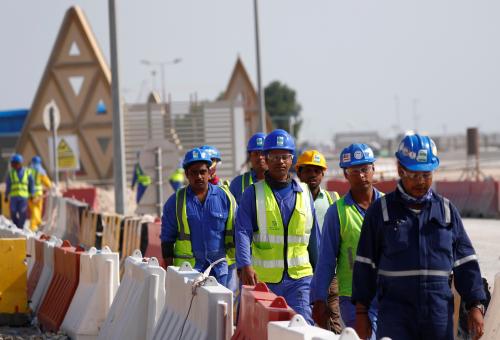Content from the Brookings Doha Center is now archived. In September 2021, after 14 years of impactful partnership, Brookings and the Brookings Doha Center announced that they were ending their affiliation. The Brookings Doha Center is now the Middle East Council on Global Affairs, a separate public policy institution based in Qatar.
Increased digitalization can significantly enhance economic opportunities for young people, says Nader Kabbani. This article was originally published by the Italian Institute for International Political Studies.
While digitalization holds the promise of enhancing youth employment in the Middle East and North Africa (MENA) region, the region is falling behind in digital infrastructure, governance, and skills. Only through fundamental structural reforms can the MENA region take advantage of new digital frontiers.
The Conundrum of Youth Unemployment in MENA
For over 30 years, the MENA region has had the highest rates of youth unemployment in the world, ranging between 23% and 27%, around twice the global average. Youth unemployment is pervasive across nearly all MENA countries. Among non-conflict countries, youth unemployment rates are highest in Jordan (37%), Tunisia (35%), and Saudi Arabia (35% among young Saudi citizens). These three countries span MENA’s three subregions, suggesting that youth economic marginalization is pervasive across the region. Youth unemployment rates are even higher in MENA countries suffering conflict and financial collapse. The one exception is Qatar, which has the financial resources to place all young citizens who want a job into well-paying positions in the public or quasi-public sectors.
The high rates of youth unemployment in the MENA region are driven by a combination of supply and demand side factors. On the demand side, the legacy of state-led economic development has led to a bloated public sector unable to absorb new labour market entrants and an over-regulated private sector — further crippled by nepotism and cronyism — that has been unable to grow and generate the necessary number of jobs. On the supply side, weak education systems produce young jobs seekers who lack the knowledge, skills, and abilities sought by the private sector. In addition, most young job seekers in MENA enter the labour market with little experience and lack adequate knowledge around how to navigate the job search process and what to expect in terms of responsibilities and compensation.
MENA governments have introduced a plethora of public policies, programs, and strategies aimed at addressing the youth unemployment challenge in their countries, but with little noticeable impact on overall unemployment levels. While intention is there, implementation has consistently fallen short. This does not bode well either for economic prospects or social stability in the region. High rates of youth unemployment and joblessness are thought to have played a key role in the social unrest afflicting the region since 2011, mobilizing young people to call for greater economic participation and social justice. Only Qatar and the United Arab Emirates (UAE), which have the resources to secure employment for their young populations, have not witnessed any significant social unrest since 2011.
Digitalization can Enhance Opportunities but Exacerbate Inequalities
Increased digitalization can significantly enhance economic opportunities for young people. Digital platforms, such as Upwork, can help skilled young people access gig opportunities across the world. Sharing economy platforms, such as the ride-sharing app Careem, support unskilled young people in earning a living. Mobile payment platforms, like Sadad, assist young entrepreneurs in making and receiving payments. Online funding platforms, such as KIVA Arab Youth, can help young entrepreneurs access finance. The MENA region can point with pride to a handful of entrepreneurs across the region who leveraged new digital technologies to create opportunities for themselves and others, including Ronaldo Mouchawar, who co-founded Souq.com, and Samih Toukan, who founded Maktoob.com, both in their early thirties.
However, breakout successes in the region are few. Most young people seeking to engage with — and benefit from — the digital economy struggle to compete with their high-skilled, well-funded counterparts in other parts of the world. While digital technology creates opportunities, it also increases competition. Furthermore, some young people are far more equipped to take advantage of these opportunities than others by virtue of their ability to access broadband networks, develop their skills, and receive the mentorship and support they need to succeed. Thus, digital technology can exacerbate existing inequalities, favoring connected urban centers, educated youth who can navigate the digital jungle, and a privileged few who can access networks of educated, wealthy, and connected friends and family.
The MENA Region is Falling Behind
There are three main obstacles preventing young people in the MENA region from fully accessing the benefits and opportunities created by digital technologies.
First, traditional laws, regulations, and bureaucratic controls in the MENA region are cumbersome and serve to protect vested interests, preventing entrepreneurs from pursuing truly disruptive innovations that can unlock economic growth and create meaningful work for others. Furthermore, in their 2020 paper, Jaller and Molinuevo find that the MENA region “is falling behind in establishing a modern governance framework for the digital economy,” relying on laws that were not originally intended for the digital era. Such modern governance frameworks include electronic documentation and signature, online consumer protection, data governance, cybersecurity, and intermediary liability regulations.
Second, the region has fallen behind in terms of access to digital technology. According to the International Telecommunication Union, mobile-cellular telephone subscriptions in the Arab region is on a downward trajectory, falling below 100% in 2020, while active mobile-broadband subscriptions were only at 60%, far behind the rest of the world, except Africa. Also worrisome is the lag in integrating technology to improve access to other services. For example, according to the Global Financial Inclusion Database, only 34% of young people in MENA had an account at a financial institution or with a mobile-money-service provider in 2017, scoring even lower than sub-Saharan Africa.
Third, leveraging technology to take full advantage of the opportunities it affords requires technical, basic, and digital skills. For example, giving people lifts using Uber requires keeping vehicles in good condition and engaging with customers to secure high ratings; while offering a service on Fiverr or Upwork requires strong technical proficiencies and the ability to engage with clients and meet deadlines. Unfortunately, most young people in MENA lack the skills to fully take advantage of the opportunities offered by digital technology. Education systems in the region remain stuck in the past and emphasize rote memorization above critical thinking, teamwork, communication, and, naturally, digital skills.
Unlocking the Potential of Digital Technology
MENA governments must undertake structural reforms to unlock the potential of digital technology to contribute to inclusive growth and reduce youth unemployment. These include: (1) reducing burdensome regulations and enhancing modern governance frameworks; (2) improving digital infrastructure, including broadband and other technologies and ensuring equal access for individuals and communities; and (3) reforming education systems to prepare young people for the jobs of the future by reducing overreliance on knowledge transfer and enhancing 21st century skills.
The Brookings Institution is committed to quality, independence, and impact.
We are supported by a diverse array of funders. In line with our values and policies, each Brookings publication represents the sole views of its author(s).




Commentary
Op-edHow will digitalization affect youth employment in MENA?
Thursday, May 6, 2021